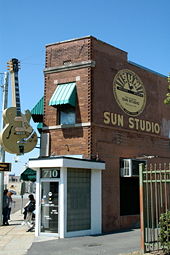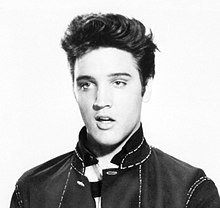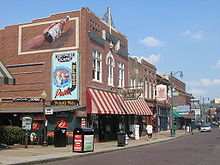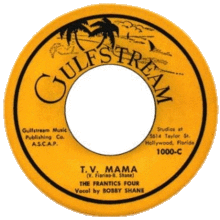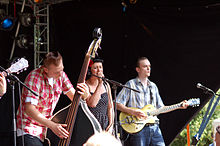Rockabilly
Rockabilly is one of the varieties of rock 'n' roll . It developed until the mid-1950s, when young, mainly white musicians in the American southern states reinterpreted black rhythm & blues in their own way and with familiar instruments and mixed it with country music .
Since the boom of this music, which initially had no uniform name and was sometimes simply classified under pop , country or rhythm and blues, did not extend beyond the borders of the southern states, some performers tried from around 1956 to shake off the rural undertone of this style in order to also to have national success. The term rockabilly only gradually gained acceptance, because the association with hillbilly ("country egg", "hillbilly") emphasized the provincial, rural nature of this music. The term only became popular and known to a wide audience during the rockabilly revival in the early 1980s.
history
Beginnings
At the center of the development of rockabilly was the small label Sun Records in Memphis , Tennessee . Founder Sam Phillips was a bluegrass musician with an affinity for rhythm & blues , then called "Race Music", the music of the black underclass. At that time, one of the centers of this music was right in Memphis, namely on the notorious Beale Street , which was home to the hottest black blues clubs, prostitution, gambling and carnival parades with elements of voodoo . Phillips had already made a name for himself in the R&B scene in the early 1950s by producing Big Joe Turner and thus helping to create the Beale Street blues and make black music available to a wide, white audience close. His label had both white and black musicians under contract, which was extremely unusual at the beginning of the 1950s, because at that time there was such restrictive racial segregation in the entire south that one can speak of two parallel, almost hermetically closed music worlds, each with their own clubs , Labels, record stores and radio stations.
A youth protest culture has been simmering in the white middle class since the late 1940s , initially defined by “ soft drugs ” and the literature of the Beat Generation . Books such as The Catcher in the Rye , published in 1951, also achieved cult status among young people because they were the first to describe a particularly youthful attitude towards life in which common morals were perceived as narrow and disruptive. However, a uniform youth music was initially missing. The fans of beat literature preferred bebop jazz, otherwise secretly listening to black radio stations, whose ghetto music conveyed sexually explicit themes, was a widespread act of rebellion against parents. Sam Phillips saw a gap in the market for his idea of new, black and white pop music, especially among young people. The young Elvis Presley , from 1954 with Sun, served him alongside others as a connecting element of both music hemispheres, because he had a good shot of gospel and rhythm & blues in his voice.
In the mid-1940s the hillbilly boogie developed, a variant of country music that was reminiscent of early rockabilly. One of the first hillbilly boogie title was the Birmingham Bounce by Hardrock Gunter . This rhythmically faster variant of country music was still played with the typical instruments of fiddle , pedal steel guitar , guitar and double bass , but the lyrics already largely deviate from the otherwise more demanding lyrics of country, so expressions such as "rock" have been used. and "roll"; Phrases that were only used in the colloquial language of African American people at the time. Some notable country musicians of the late 1940s, as well as unknown musicians, joined the hillbilly boogie, including Tennessee Ernie Ford , The Delmore Brothers , The Carlisles , Merle Travis , Roy Hall, and Red Foley .
Ascent
Music historians often refer to Bill Haley's cover of R&B hit Rock the Joint from 1952 as the first rockabilly song on record. This recording was the first to hear Marshall Lytle's slap-back technique on the saddlemen's bass. In addition to the slap bass, the electric guitar and the acoustic guitar, Haley was also accompanied by a piano and a steel guitar. Craig Morrison, author of the book Go Cat Go! , describes Haley and his saddlemen as a "small western swing formation that played R&B pieces". Furthermore, he also says that Rock the Joint would move in the direction of Rockabilly ("Certainly 'Rock the Joint' does point towards Rockabilly"). In addition, Eddie Zack's I'm Gonna Roll and Rock is also rated as the first rockabilly song. Because of the existence of these two titles, opinions about the first rockabilly song on record differ among music historians.
The first Sun rockabilly title in history is the 1954 recording That's All Right by 19-year-old Elvis Presley, together with Scotty Moore (guitar) and Bill Black (bass), which was made from a recording of a break from playing. The brass and drum-free economy cast is a typical white country line-up that goes back to the conservative regulations of the Grand Ole Opry in Nashville, the most important country show in the USA. Deliberately differentiating it from the boom in swing and big band music at the time, the aim was to maintain the music that the ancestors of country music had done, such as the Carter Family . Accordingly, drums and wind instruments were not permitted on the Opry stage until the mid-1950s.
In order to still generate a stirring rhythm with the Opry-compatible sparing instrumentation, the double bass took the place of the percussion instrument. Bill Black played in the slap technique , a style of playing developed in Dixieland Jazz in which the strings clap on the fingerboard. In addition, a tape echo compensated for the missing drums and created a characteristic groove that “bubbled” in time. This echo groove mainly characterizes the Sun sound, but it was also used by other rockabilly artists, such as Gene Vincent , who used it to support his voice. The lead guitar played sparingly picked, high notes on the second beat of the measure, as well as boogielicks on the bass strings. The singing was often in a nervous “hiccup style”, sometimes country-nasal ( Carl Perkins , Charlie Feathers ), sometimes with black swing like Charlie Rich or even with gospel-like, black decorations like Elvis Presley. After the early phase of rockabilly, drums found their way into music, often also the piano with shuffled riffs in the left hand, in the style of New Orleans Rhythm & Blues. The preferred lead guitars were archtop models from Gibson or Gretsch , and later solid wood guitars such as the Fender Telecaster or the Gibson Les Paul .
While the Presley, Moore and Black tracks have had amazing sales in and around Memphis since being played on local radio, it was more because of the spectacular live performances that this new music quickly became a talking point and the bill for Sam Phillips rose. The three musicians soon called themselves The Bluemoon Boys and from 1954 toured alone or together with other Sun musicians such as Carl Perkins and Johnny Cash through the entire southern United States, where they caused hysteria mainly because of the wild stage show by Bill Black and Presley and sparked outrage. The controversial appearances sparked a real Sun Sound fever. Wherever the Sun people made guest appearances, performers emerged a little later, some of whom produced copies of the Sun sound that were very close to the original. An example is Charles Hardin Holley, a young country musician from Lubbock in Texas , in 1956 in his home saw a performance by Presley and immediately bought an electric guitar in order to shift to the new style and under the name Buddy Holly story write. Eddie Cochran should also be mentioned here, and Gene Vincent, who developed an independent, much more aggressive, more urban rockabilly style, in which even doo-wop elements sometimes sounded. Gene Vincent's guitarist Cliff Gallup was also heavily influenced by the virtuoso jazz-pop guitarist Les Paul and built surprising changes in harmony and technically demanding licks into his solos.
Nevertheless, rockabilly rarely succeeded in producing national hits. The provincial note was too strong, the southern accent of many singers was unmistakable. After about three years, the rockabilly boom subsided and most performers turned to traditional country music. Few of them, like Elvis Presley, succeeded in shedding the local flavor and achieving national or even global success with an adapted mainstream rock'n'roll. In 1956, at the height of the rockabilly boom, Presley moved from Sun to record giant RCA Victor . This change marks the turning away from rockabilly, although Presley's first RCA sessions, initially recorded with the old band, are still clearly rockabilly. Carl Perkins' original version of Blue Suede Shoes, followed by Presley's cover version of the same song, offers a good comparison between cozy, rural rockabilly and mainstream rock'n'roll .
Rockabilly in the present
Especially in Europe and Japan, an independent rockabilly community has developed with forums, festivals and magazines. The Hemsby Rock'n'Roll Weekend has been taking place in England since 1988 , with both new and original musicians performing. In the past there were and are other international events, such as B. Between 1985 and 2004 in Munich the International Rock 'n' Roll / Rockabilly Meeting , in England the Rockabilly Rave and the Rockabilly Reunion .
There is also an active rockabilly scene in the USA. In Tennessee, the Rockabilly Hall of Fame has its headquarters, the parties, Internet activities and the like organized. It competes with the less popular International Rockabilly Hall of Fame from Jackson , Tennessee . The world's largest rockabilly festivals take place in Green Bay and Las Vegas every year. Within the country scene, rockabilly played an important role as a style element or as an independent direction, e.g. B. in the music of the bands BR5-49 , The Derailers or Asleep at the Wheel .
Centers of rockabilly
Generally speaking, the rockabilly movement took place in the southern United States. In the following the most important, best known or most original centers of rockabilly are described. In these areas, usually an area around a city, the music scene was particularly lively due to local record labels, radio shows or clubs.
Memphis, Tennessee
Memphis is undisputedly regarded as the birthplace and most pronounced center of rockabilly. The beginnings were found in the fact that rhythm and blues and country music were equally popular in the city. The Saturday Night Jamboree , on the air from 1953 to 1954, gave the young talents the opportunity to appear publicly on the radio and in front of an audience for the first time. Later important representatives like Johnny Cash, Eddie Bond, Elvis Presley or the bass player Marcus Van Story gained their first experiences there. The Saturday Night Jamboree was probably the first place that rockabilly was played live.
The record labels Sun and Meteor also favored rockabilly. Many musicians traveled to Memphis in hopes of getting a contract with Sun. Often Sam Phillips could not accommodate many artists and passed them on to Les Bihari, owner of Meteor Records. After the success of Sun, other labels such as Moon Records , Fernwood Records and Hi Records were founded in the middle and at the end of the decade , all of which also included more or less well-known representatives of the music scene.
Well-known musicians from Memphis or who worked there included Presley, Perkins and Cash Warren Smith , Eddie Bond , Johnny Burnette , Jack Earls , Ray Harris , Charlie Feathers , Billy Lee Riley , Roy Orbison , Smokey Joe Baugh , Slim Rhodes , Wade and Dick , Brad Suggs , Johnny Bernero, and Malcolm Yelvington .
Texas
Along with Memphis and the West Coast, Texas was one of the most important rockabilly centers of the 1950s. With the KRLD Big D Jamboree , which was broadcast nationwide, the scene at that time had ample opportunity to present itself. Texas produced well-known representatives such as Buddy Holly , Sid King , Sonny Fisher , Don Woody , Mac Curtis and George Jones , who recorded rockabilly as "Thumper" Jones. Texas had many different small record labels, often only lasting a year or two. Important labels were Starday Records and Dixie Records , D Records , TNT Records and Lin Records . The rockabilly in Texas was often called texabilly .
United States West Coast
West Coast rockabilly was often influenced by western swing , which found an influential representative of California in Spade Cooley in the 1950s. Various radio stations such as KXLA offered musicians jobs in their programs, which often influenced its popularity. The Town Hall Party , broadcast from 1951, was particularly popular with rock 'n' roll and rockabilly from 1955 and became one of America's most popular radio and television shows.
The resident major label Capitol Records also had an influence on rockabilly that should not be underestimated. Capitol had well-known and mostly successful musicians such as Wanda Jackson , Gene Vincent , Joe Maphis and the Collins Kids under contract. The smaller labels Four Star , Abbott and Fabor, like Sun, had the task of discovering and promoting the talents, but then passed them on to the larger companies. Other representatives included Sammy Masters , Skeets McDonald , Glen Glenn , Tom Tall and Ruckus Tyler .
The Rockabilly created an important basis for the beginning of the 1960s in Bakersfield resulting Bakersfield Sound . Its most important representative, Buck Owens , began his career in 1956 under the pseudonym "Corky Jones" with rockabilly titles on a small label. At the same time he was active as session music for Capitol and thus played on recordings by the Farmer Boys .
Miami, Florida
In Miami , an independent scene developed from the 1955th Although the artists usually never achieved more than regional fame, the city still had an active music scene. Benefiting from Miami's "heyday" in the 1950s and 1960s and the Arthur Godfrey Talent Show that aired from Miami, there were many local rockabilly musicians in Miami and its sister city, Miami Beach . National or supraregional labels were rarely found in the city. Best known are Harold E. Doanes Art Records , Buck Trails Trail Records, and Vincent Fiorinos Gulfstream Records .
In addition to the two local radio shows, the Gold Coast Jamboree from WMIE and the Old South Jamboree from WMIL, it served as a presentation location and platform for many musicians. Probably the best-known musician from Miami is Tommy Spurlin , who was a member of the Gold Coast Jamboree with his Southern Boys and has released various singles on Art and Perfect. His song Hang Loose increased enormously in value during the rockabilly revival.
see also: Miami Rockabilly
Phoenix, Arizona
Phoenix was also a rockabilly center from 1955 to 1956, albeit to a lesser extent than Memphis or Texas. Lee Hazlewood , who had his first experiences as a producer with local musicians, played a decisive role . With Sanford Clark's The Fool , he recorded his first top ten hit in 1956. He had previously recorded Jimmy Johnson , Jimmy Dell and Duane Eddy . As in other centers, Phoenix had a radio show that influenced or promoted the scene, the KRUX Arizona Hayride .
After 1956, Phoenix's rockabilly scene saw a major decline.
Importance of rockabilly
Although there were hundreds of rockabilly artists in the heyday of rockabilly (1954/55 - 1958), only very few made it to the charts or had any other commercial success. Most artists therefore usually did not publish more than two or three records. In addition, the rockabilly, with a few exceptions on the west coast of California and Florida , was limited to the American southern states, which was also a reason for the failure of most rockabilly singers.
Rockabilly is the style of country music in most circles, but on the surface they have little in common. Almost all musicians had their roots in country music or even recorded country tracks. After rockabilly came to an end in 1960, many singers continued to try their hand at country artists, such as Mac Curtis , Warren Smith , Eddie Bond or Sanford Clark . In addition, rockabilly is also part of rock'n'roll, which has unmistakable similarities, such as the often hard way of playing. However, rockabilly is not a decisive part, neither did it have a particularly strong influence on rock'n'roll, nor did rock'n'roll begin or end with it.
However, the rockabilly exerted a strong influence on the British Invasion , as both the Beatles and the Rolling Stones started their careers with covers of Carl Perkins, Buddy Holly and others and were avowed Elvis fans. The Who , who did not have as strong a connection to rockabilly as the Beatles or the Rolling Stones, covered Eddie Cochran's Summertime Blues on their album Live at Leeds . Also, the Punk was co-influences of rockabilly, especially the band The Clash , who even rockabilly songs recorded some.
Even hard rock musicians like Jeff Beck or Jimmy Page paid tribute to rockabilly, including with tribute albums. Jeff Beck recorded an album that only consists of Gene Vincent songs ( Crazy Legs ) and Jimmy Page founded the band The Honeydrippers with his former Led Zeppelin colleague Robert Plant , which was heavily influenced by the sound of the 1950s and even some rockabilly live -Covered classic. Elvis Presley had already been offered as a backing band during the Led Zeppelin era, but he declined this offer.
With the rockabilly of the 1950s, however, the basis for many today's bands or styles of music based on rockabilly, such as punkabilly , psychobilly or gothabilly, arose . These styles not only took over the economical instrumentalization, but often also the typical "sip on" singing.
Audio samples and other representatives
|
Typical representatives |
Compilations
|
Typical songs
|
Audio samples
The typical slap technique is, for example, in Elvis Presley's I Don't Care if the Sun Don't Shine and Baby Let's Play House , Eddie Cochran's Twenty Flight Rock , Jimmys and Johnny's Sweet Love on My Mind , Skeets McDonalds You Oughta See Grandma Rock and Heartbreakin Mama as well as the little-known Andy Starr on Rockin 'Rollin' Stone .
The high notes played by the lead guitar on the second beat, as well as the boogie licks, can be heard especially with Elvis Presley's guitarist Scotty Moore and Carl Perkins. Examples are Carl Perkins with Honey Don't , and Elvis Presley with Good Rocking Tonight .
Examples of the typical "bubbling hiccups" in connection with the tape echo are offered by Presley 's Baby Let's Play House and Pat Cupp from Arkansas with Do Me No Wrong . The sometimes punk-like choppy way of singing Johnny Burnette is another example, especially his title Train Kept A-Rollin ' . Also to be mentioned is Gene Vincent , who also used the echo effect developed by Sun to create the bubbling rockabilly groove. Bluejean Bop or Race with the Devil can be cited as examples . Johnny Cash's Leave that Junk Alone provides a particularly clear example of the typical hiccup chant .
Presley's version of Milkcow Blues Boogie by Kokomo Arnold is an example of the rare black decorations in the voice in rockabilly . The unmediated "falsetto kieks" give the song a white cowboy feeling. This interpretation is black and white at the same time, a disconcerting cross-reference to common listening habits at the time.
The title Greenback Dollar by Ray Harris from 1957 is a particularly good example of rockabilly. You can clearly hear the bassist's slapping bass style, Harris' hiccup singing and the simple instrumentation (acoustic guitar, E. -Guitar, double bass, drums, piano). The piece is actually an old traditional folk song recorded by Ray Harris at Sun Studios in 1957. Due to the rough style, however, the single never got beyond regional success.
Also an old folk song, Crawdad Hole was recorded in 1956 by Jack Earls and the Jimbos . With the economical cast and the slap technique, the piece is typical for rockabilly. The recording was originally never released by Sun Records, with whom Earls made the recording and was under contract at the time. What is unusual, however, is the drum solo, albeit a short one, a rare stylistic device in ordinary rockabilly.
Other representatives
Rockabilly in Europe
In Germany, a number of bands play their own German-language songs ("German Rockabilly"), such as the Ace Cats , who had a chart success in 1984 with the song Linda . A rockabilly scene has also developed in Austria since the early 1990s. Since Elvis Presley's death in 1977 and the resulting rockabilly revival, active musicians such as Sleepy LaBeef and Eddie Bond have become known in Europe.
Shakin 'Stevens and the Sunsets have had success with cover versions of well-known rock'n'roll and rockabilly titles since 1969 and thus contributed to the revival. Other British bands like Crazy Cavan and the Rhythm Rockers and Matchbox were also successful. Since 1979 Shakin 'Stevens has reached number 1 in the English and Matchbox number 8 in the German charts with the song Midnite Dynamos . The rockabilly revival also started in England in the 1980s. Led by bands like Stray Cats and Restless , the so-called Neo-Rockabilly was born.
Rockabilly in the charts
The number behind the artist indicates the highest chart position on the Billboard charts . As a rule, the songs appeared in the Hot Country Songs from Billboard, otherwise it is indicated in which other hit parades the songs were placed.
1955
- Love Me - Jimmy Lee Fautheree & Wayne Walker ; # 75 (Chess, April 9, 1955)
- Baby, Let's Play House - Elvis Presley ; # 5 (Sun, May 10, 1955)
- Cry! Cry! Cry! - Johnny Cash and the Tennessee Two ; # 14 (Sun, June 21, 1955)
- I Forgot to Remember to Forget - Elvis Presley ; # 1 (Sun, August 6, 1955)
- Mystery Train - Elvis Presley ; # 11 (Sun, August 6, 1955)
1956
- Blue Suede Shoes - Carl Perkins ; C&W # 1 / Pop # 1 / R'n'B # 1 (Sun, January 1, 1956)
- So Doggone Lonesome - Johnny Cash and the Tennessee Two ; # 4 (Sun, January 7, 1956)
- Honky-Tonk Man - Johnny Horton ; # 9 (Columbia, March 10, 1956)
- Will You, Willyum - Janis Martin ; Pop # 35 (RCA, April 7, 1956)
- Boppin 'the Blues - Carl Perkins ; # 7 (Sun, May 1956)
- Ooby Dooby - Roy Orbison ; # 59 (Sun, May 1956)
- Be-Bop-A-Lula - Gene Vincent ; Pop # 7 / C&W # 5 / R'n'B # 8 (Capitol, June 2, 1956)
- Hula Skirt - Hank Snow ; # 4 (RCA, June 23, 1956)
- The Fool - Sanford Clark ; C&W # 15 / Pop # 10 (Dot, June 1956)
- I Gotta Know - Wanda Jackson ; # 15 (Capitol, July 21, 1956)
- Dixiefried - Carl Perkins ; # 10 (Sun, August 3, 1956)
- Race with the Devil - Gene Vincent ; Pop # 96 (Capitol, September 1, 1956)
- Teenage Boogie - Webb Pierce ; # 10 (Decca, September 2, 1956)
- Go Cat Go - Bill Flagg and the Rockabillies ; # 77 [?] (Tetra, September 15, 1956)
- Bluejean Bop - Gene Vincent ; Pop # 34 (Capitol, September 23, 1956)
- My Pink Cadillac - Hal Willis ; # (Atlantic, November 10, 1956)
- The Cheat - Sanford Clark ; Pop # 74 (Dot, November 17, 1956)
- Guitar Rock - Bill Flagg and the Rockabillies ; # 75 [?] (Tetra, December 1956)
1957
- I'm Coming Home - Johnny Horton ; # 11 (Columbia, Jan. 5, 1957)
- Your True Love - Carl Perkins ; # 13 (Sun, January 23, 1957)
- So Long, I'm Gone - Warren Smith ; # 72 (Sun, May 20, 1957)
- Lotta Lovin ' - Gene Vincent ; Pop # 13 / R'n'B # 7 (Capitol, July 8, 1957)
- Wear My Ring - Gene Vincent ; Pop # 13 (Capitol, July 8, 1957)
- Roc-A-Chica - Warner Mack ; # 74 (Decca, October 21, 1957)
- Dance to the Bop - Gene Vincent ; Pop # 23 (Capitol, October 23, 1957)
- Waitin 'in School - Ricky Nelson ; # 12 (Imperial, December 9, 1957)
- Big River - Johnny Cash and the Tennessee Two ; # 4 (Sun, December 1957)
- Drive in Show - Eddie Cochran ; Pop # 82 (Liberty, 1957)
1958
- Bop-A-Lena - Ronnie Self ; Pop # 63 (Columbia, February 3, 1958)
- Believe What You Say - Ricky Nelson ; # 10 (Imperial, March 10, 1958)
- My Bucket's Got a Hole in It - Ricky Nelson ; # 10 (Imperial, March 10, 1958)
- Whole Lotta Woman - Marvin Rainwater ; C&W # 15 / Pop # 60 (MGM, March 1958)
- Leory - Jack Scott ; Pop # 11 / R'n'B # 5 (Carlton, April 14, 1958)
- Poor Little Fool - Ricky Nelson ; # 1 (Imperial, June 23, 1958)
- All Grown Up - Johnny Horton ; # 8 (Columbia, July 21, 1958)
- All Over Again - Johnny Cash and the Tennessee Two ; C&W # 4 / Pop # 38 (Columbia, September 1958)
- Summertime Blues - Eddie Cochran ; Pop # 8 / R'n'B # 11
1959
- White Lightin ' - George Thumper Jones ; C&W # 1 / Pop # 73 (Mercury, February 9, 1959)
- Luther Played the Boogie - Johnny Cash and the Tennessee Two ; # 8 (Sun, February 15, 1959)
- I Never Felt Like This - Jack Scott ; Pop # 78 (Carlton, March 2, 1959)
- The Way I Walk - Jack Scott ; Pop # 35 (carlton, June 1, 1959)
- Katy Too - Johnny Cash and the Tennessee Two ; C&W # 11 / Pop # 66 (Sun, June 2, 1959)
- Who Shot Sam - George “Thumper” Jones ; C&W # 7 / Pop # 93 (Mercury, June 1959)
- Tomorrow Night - Carl Smith ; # 24 (Columbia, October 1959)
Music industry
Institutions
- Rockabilly Hall of Fame
- Rockabilly Music Association
Record labels
A lot of rockabilly recordings were made on small, independent “independent” labels. As a result, producers often did not have the financial means to effectively market their artists.
Original labels from the 1950s:
- 4 Star Records
- Fernwood Records
- Goldband Records
- Hi records
- King Records
- Meteor Records
- Moon Records
- Starday Records
- Sun Records
Re-release labels:
- Ace Records
- Bear Family Records
- Buffalo Bop
- Collector Records
- Hydra Records
- Proper records
- Redita Records
- Rollin 'Rock Records
- Stomper Time Records
- Sleazy Records
The rockabilly fashion
The term rockabilly, which was originally only used for a certain type of music, has been expanded and also refers to certain hairstyles, jewelry and clothing that take up or even copy what were perceived as characteristic and actual style features of the 1940s and 1950s. Rockabilly fans fall back on the great stylistic range of these decades. These fashion quotes are often combined with tattoos , with certain motifs such as cherries, skulls, flaming hearts, etc. being popular. The so-called "greaser look", which is often portrayed in the media, in which the men have expansive haircuts with pomade and long sideburns and wear tight jeans or black trousers with creepers and the women with plate skirts and petticoats , has meanwhile become almost permanent Cliché freezes.
literature
Novels
- Price, Richard: Scharfe Zeiten , Rowohlt, Reinbek 1976 ISBN 3-498-052292 , made into a film under the title The Wanderers
- Uwek, Wolf: Teddy Boy , Bäßler, Berlin 1995 ISBN 3-930388-07-3
- Documentary film Rockabilly Ruhrpott
Reconditions
- Morrison, Craig: Go Cat Go !: Rockabilly Music and its Maker , Music in American Life 1998 ISBN 978-0252065385
- Poore, Billy: Rockabilly: A Forty-year Journey , Hal Leonard Corporation 2002 ISBN 978-0793591428
- El-Nawab, Susanne: Rockabillies - Rock 'n' Roller - Psychobillies, Portrait of a Subculture , Archive of Youth Cultures Verlag KG, Berlin 2005 ISBN 3-86546-035-6
- Stobbe, Britta: Keep on rockin '- A life in Rock'n'Roll , Books on Demand, Norderstedt 2008 ISBN 978-3-8370-3369-4
- Shaylor, Andrew: Rockin ': The Rockabilly Scene , Merrell Publishers 2011 ISBN 978-1858945286
- Beyer, Jennifer: Rockabilly and Rock'n'Roll between tradition and modernization , Books on Demand, Norderstedt 2011 ISBN 978-3-640-96728-5
- Décharné, Max: A Rocket in My Pocket: The Hipster's Guide to Rockabilly Music , Serpent's Tail 2011 ISBN 978-1846687211
- Dregni, Michael: Rockabilly: The Twang Heard 'Round the World: The Illustrated History Book , Voyageur 2011 ISBN 978-0760340622
- Bregg, Billy: Roots, Radicals and Rockers , Faber and Faber Ltd. 2018, ISBN 978-0571327751
Individual evidence
- ↑ Craig Morrison: Go Cat Go! Rockabilly Music and its Makers . University of Illinois Press, p. 35
- ^ Guralnick: Last Train to Memphis . P. 104 f.
- ↑ Hemsby Rock N Roll Weekend. In: hemsbyrocknroll.co.uk. Retrieved August 29, 2016 .
- ↑ Events All Around - Home. In: lakehavasurockabillyreunion.com. Retrieved August 29, 2016 .
- ↑ Viva Las Vegas: home. In: vivalasvegas.net. Retrieved August 29, 2016 .
- ↑ Rockabilly Hall of Fame - Saturday Night Jamboree
- ↑ Ace Records: Miami Rockabilly ( Memento of the original from October 11, 2007 in the Internet Archive ) Info: The archive link was inserted automatically and has not yet been checked. Please check the original and archive link according to the instructions and then remove this notice.
- ^ Roy Carr, Mick Farren: Elvis: The Illustrated Record . Harmony Books, 1982, p. 160.
